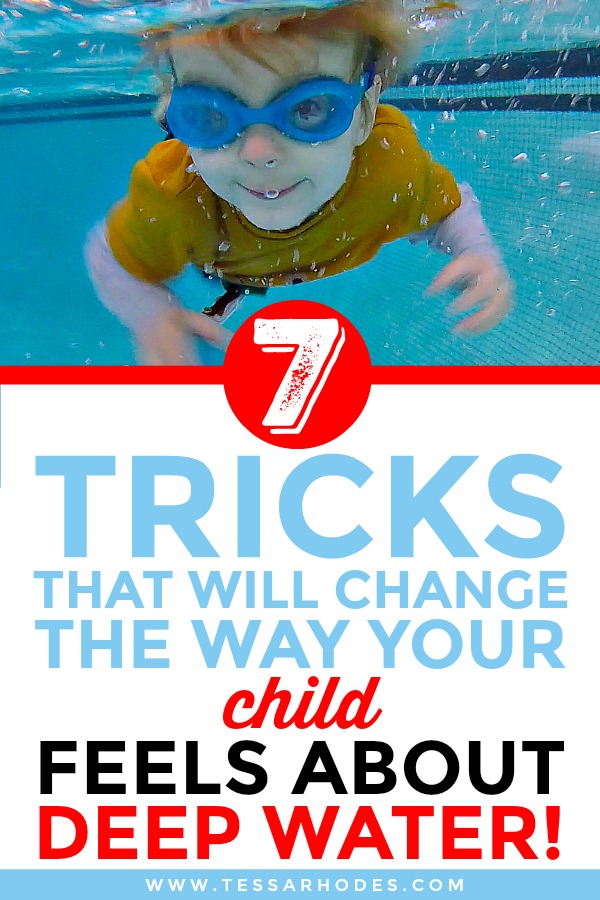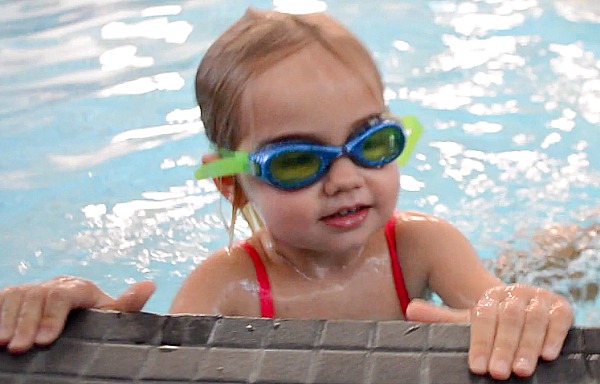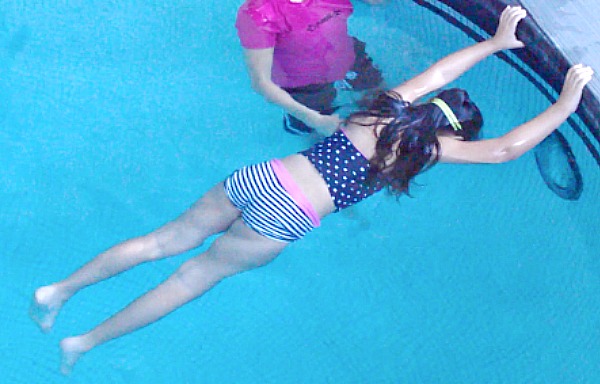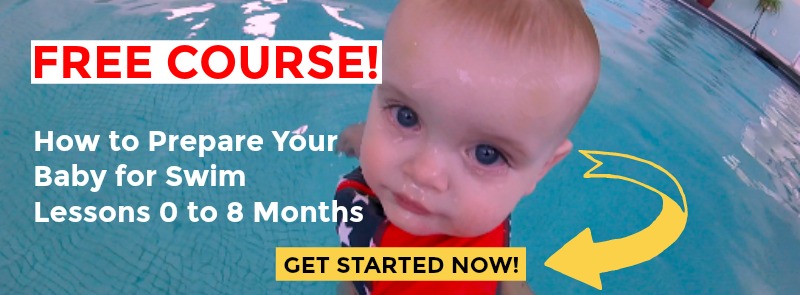If your child is completely comfortable in shallow water, then she is ready to conquer her fear of deep water.

(This post contains an affiliate link)
By completely comfortable, I mean she can float on her front independently for at least ten seconds. She can back float unaided for at least thirty seconds. And finally, she can roll in various ways, propel through the water, bob, and dive for objects.
Now she is ready to take these skills and apply them to deeper waters.
Shallow water vs. deep water
Ask your child, “what do you think will happen when you try to float in the deep water?”
Chances are, she’ll reply with a resounding “I’ll sink!”
At this point, you’ll want to assure her that the deep water is the same as the shallow water. It does just as good a job of supporting her as the shallow water.
She will probably not be convinced just yet until she experiences it for herself.
How long it will take before your child is comfortable in the deep water will depend on your child and her level of fear of the deep water.
Also, her age can play a factor. Older children are more willing to take chances and, therefore, acclimate to the deep end sooner than younger children.
Remember to practice patience and don’t force your child to do anything she doesn’t want to do. Follow her lead and let her go at her own pace.
Monkey walking

Make your way to the deeper water with your child by holding onto the gutter or edge of the pool with both hands, moving along one hand at a time. This activity is called monkey walking.
She might want to monkey walk all the way to the deepest part of the pool, or she may only be willing to go as far as shoulder or neck deep water. That’s okay. Start with whatever she’s comfortable.
Each time you practice with her, encourage her to go a little bit deeper even if it’s just a few inches further along the wall than it was the time before. If she’s not willing, don’t force it.
Remember always to practice patience and let her go at her own pace. She may not progress as fast as you would like, but if you force her, it will only prolong the process.
Front float in deep water

Practice the front float in the shallow end first.
Her front float should be relaxed with her head in a neutral position while letting her arms and legs float naturally and she should be able to do this for ten seconds or more.
Remind her that the deep water will support her just as well as the shallow water as long as she keeps it consistent.
Time to monkey walk toward the deep end to try the front float. Stop wherever she decides, even if it’s only in shoulder-deep water.
Have her hold onto the gutter or wall, hold her breath, put her face in the water looking at the bottom, and don’t let go. Have her do this for about five seconds or more.
Ask her if she was holding herself up or was the water holding her up. She’ll likely say that the water was holding her.
If she’s ready to let go, make sure she drops her hands into the water. Since lifting them up above the water will make her sink slightly.
Remember that the front float doesn’t have to be horizontal. If the legs dangle, let them dangle.
Back float and otter roll in deep water
Before making your way to the deep end with your child, make sure she practices the back float in the shallow end and that it is completely independent and can do it for at least thirty seconds.
It doesn’t have to be horizontal, but it should be relaxed, and if that means her feet touch or almost touch the bottom, that’s fine. Practice otter rolls too.
Convey to her that if she can back float in the shallow end, then she can back float in the deep end.
Now it’s time to monkey walk with your child toward the deep end. Let your child decide where she wants to try the back float, even if it’s just in shoulder deep water.
When she’s ready, have her hold onto the wall or gutter, place her belly button against the wall, put her head back in the water, extend her arms, and don’t let go.
Ask her if she feels the water floating her or does she think that because she’s holding onto the wall that that’s the only reason why she’s floating. She will most likely say that the water is floating her.
If she’s ready to let go, remind her to drop her hands into the water, don’t lift them up above the pool deck or she will drop down slightly, especially if she drops her chin toward her chest.
If all goes well when she lets go, she’ll start to drift away from the wall. To get back to the wall, have her perform an otter roll.
Penguin float
A penguin float is floating vertically with a straight body, legs together and arms at your sides like a soldier. No reason you can’t call it a soldier float.
Before you have your child attempt it, ask her what she thinks would happen if she were to hold her body in a penguin position in the deep end of the pool.
Once again, she will likely respond with an unequivocal, “I’ll sink!”
Time to test the waters with the penguin float. Make your way to the deep end or as far as your child is willing.
Demonstrate this first. Hold onto the edge or gutter with one hand, the other arm at your side, legs together.
When you’re ready, hold your breath and let go of the wall. Put that arm at your side and keep your head in a neutral position (looking straight ahead).
If you’ve never done this before, you may be surprised at just how buoyant you are in this position. Some people will end up just below the surface while others will float higher exposing most of their face.
Now it’s your child’s turn. If she needs help, do this in a depth in which you can stand, but is deep enough for her. Now hold her arms at her sides then let go once she holds her breath.
Why do a penguin float?
To illustrate once again, just how buoyant we are (except for very muscular people and people with very little body fat). It proves that we’re not going to drop like a rock to the bottom even in a vertical position.
So if you want to float better, indulge in sweets, but if you want to live longer on land, moderation is key.
But seriously folks, now that you have acquired this new information, you might be thinking to yourselves “if my mouth and nose are just inches from getting air, it must take minimal effort to tread water.”
And you would be exactly right. Not that this is a lesson in treading water, but it is a step toward it.
Balloon float
Once your child has the hang of the penguin float, have her pretend to be a helium-filled balloon.
If you have a ladder in the deep end of your pool, use it for this activity, If not you can use the wall or just hold your child in position.
As you know, a helium-filled balloon rises when you let go of it. To be a helium-filled balloon, hold your breath, get yourself down to the bottom while holding the penguin position then let yourself rise back up to the surface. Holding your breath is key.
Now have your child try it. It’s fun. She’ll probably want to do it again and again.
Bobbing in deep water
Help your child work her way up to bobbing in a depth of about six or seven feet.
Start by practicing bobbing in chest or shoulder deep water. Make sure your child has a good rhythm of blowing bubbles then taking a breath and can stay in control for at least fifteen bobs.
Every time she goes under, she should bend her knees and then push off from the bottom (exactly like jumping up and down on land). Her arms should go up when she goes down, and they should go down when she goes up.
In water over her head, the arm action is even more dramatic. Starting with her arms straight and at her sides, have her sweep her arms up over her head while blowing bubbles to get down, then sweep them back down to her sides (like the wings of an eagle) with the jumping action to get back up to the surface to take another breath. Repeat this sequence multiple times.
More on deep water
Remember to be patient and let your child go at her own pace. Encourage her to go a little deeper each time, but if she doesn’t want to, don’t force it, it will only prolong the process.
Other deep water activities that you can do while accompanying her is to have her kick to the deep end while using a kick board, a swimming noodle or even my favorite, the Finis Floating Island. It’s a large mat with holes, so they can see the bottom while lying on top of the mat.
Many of my students who are still working on overcoming their fear of the deep water, surprisingly love these activities.



Leave a Reply